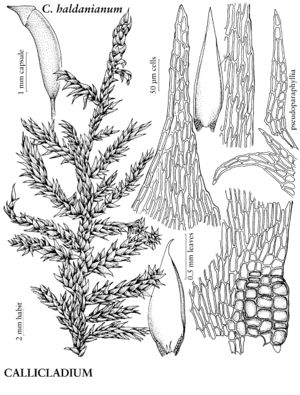Callicladium
Bryologist 74: 167. 1971.
| Taxon | Illustrator ⠉ | |
|---|---|---|
 | Callicladium haldanianum | Patricia M. Eckel |
Plants medium-sized, in extensive, flat mats, green, yellow-green, or brownish, glossy. Stems creeping, somewhat complanate-foliate, irregularly branched to subpinnate (often horizontal), branches not curled when dry; hyalodermis absent, central strand present; pseudoparaphyllia foliose. Stem and branch leaves similar, erect or erect-spreading, ovatelanceolate, widest beyond base, not plicate; base not decurrent; margins plane, entire; apex acuminate; costa double and short or occasionally ecostate; alar cells differentiated, quadrate to rectangular; laminal cells smooth; distal cells usually longer than 6: 1. Specialized asexual reproduction absent. Sexual condition autoicous; perichaetial leaves ovatelanceolate, apex long-acuminate. Seta orange-red. Capsule suberect or inclined, rectangular, not or weakly curved, contracted below mouth; annulus slightly differentiated; operculum conic; peristome double; exostome teeth with external surface usually cross-striolate basally; endostome basal membrane high, segments broad, keeled, cilia 1. Calyptra naked. Spores round, minutely papillose.
Distribution
North America, Eurasia
Discussion
Species 1.
Callicladium is distinguished by slightly flattened, tapered branches, crowded, concave leaves with a small double costa, and suberect and only slightly curved capsules. Early associations with the genus Hypnum were supported by typical hypnaceous characters: curved, inclined capsules, and terete-foliate branches with falcate-secund and often serrate leaves. The genus Heterophyllium (Sematophyllaceae) has been long associated with Callicladium but differs in its pinnate branching and differentiated stem and branch leaves that are strongly serrate. Crum chose the name Callicladium to emphasize the distinctively flattened and tapered branches.
Selected References
None.
Lower Taxa
"broad" is not a number.